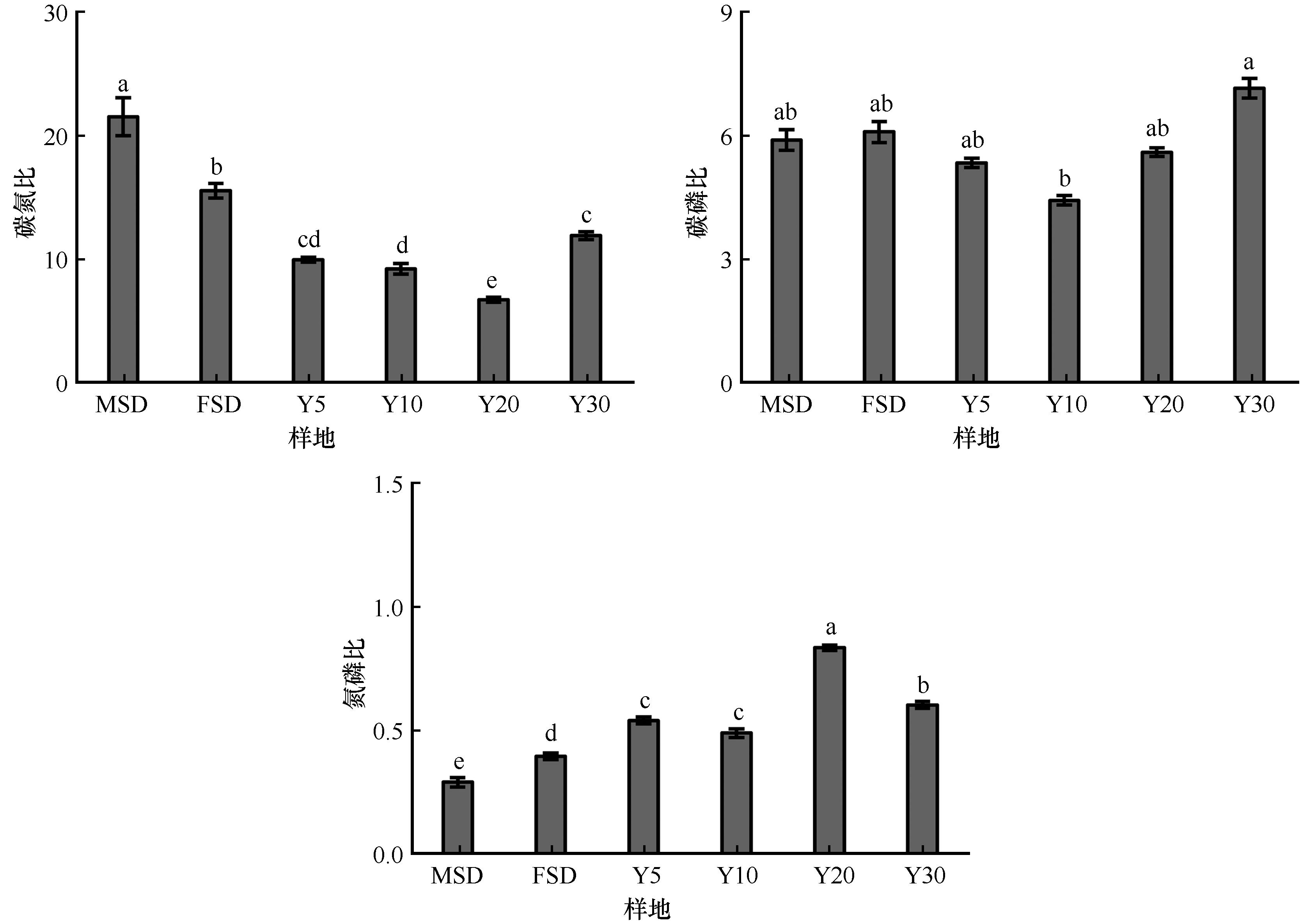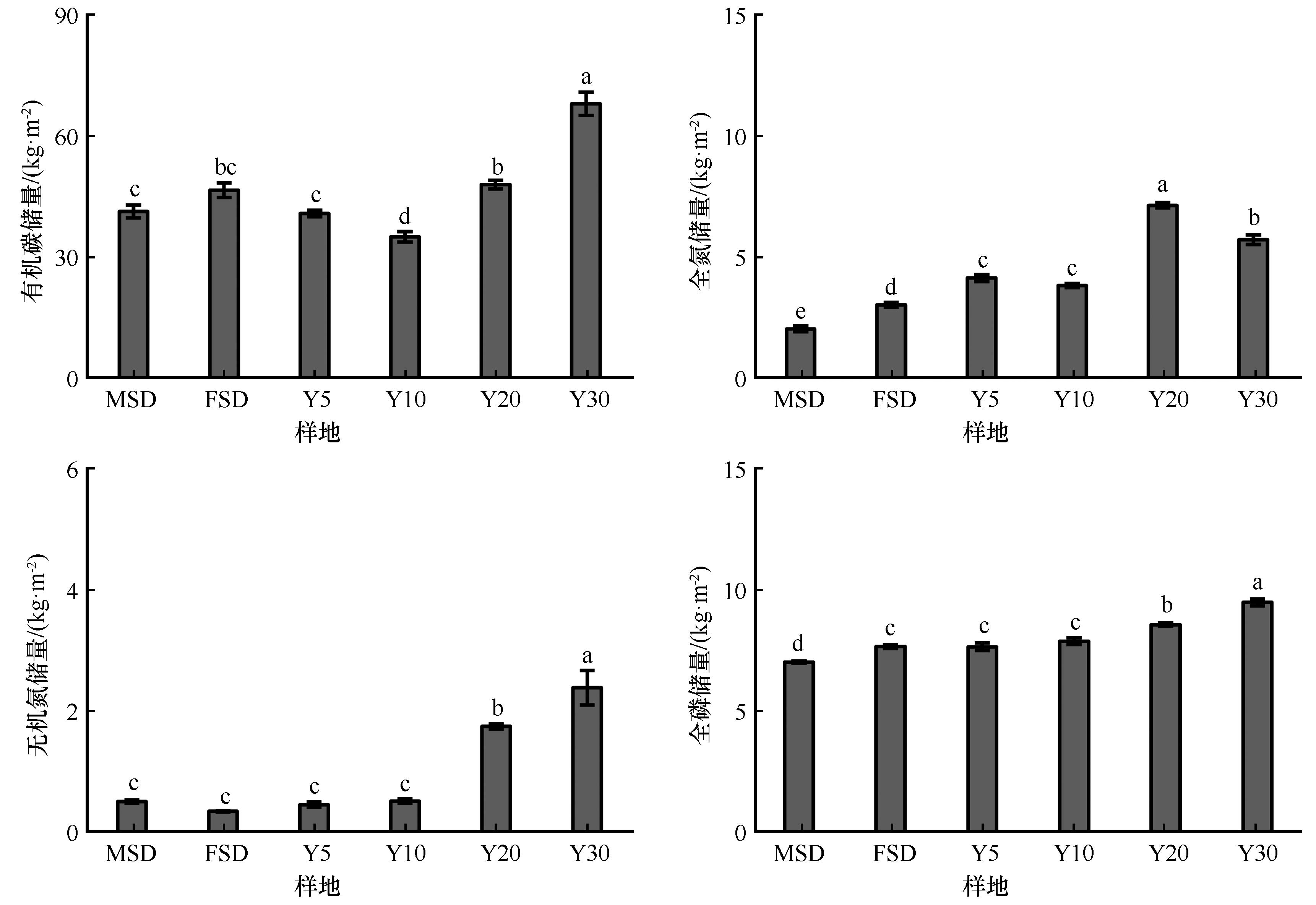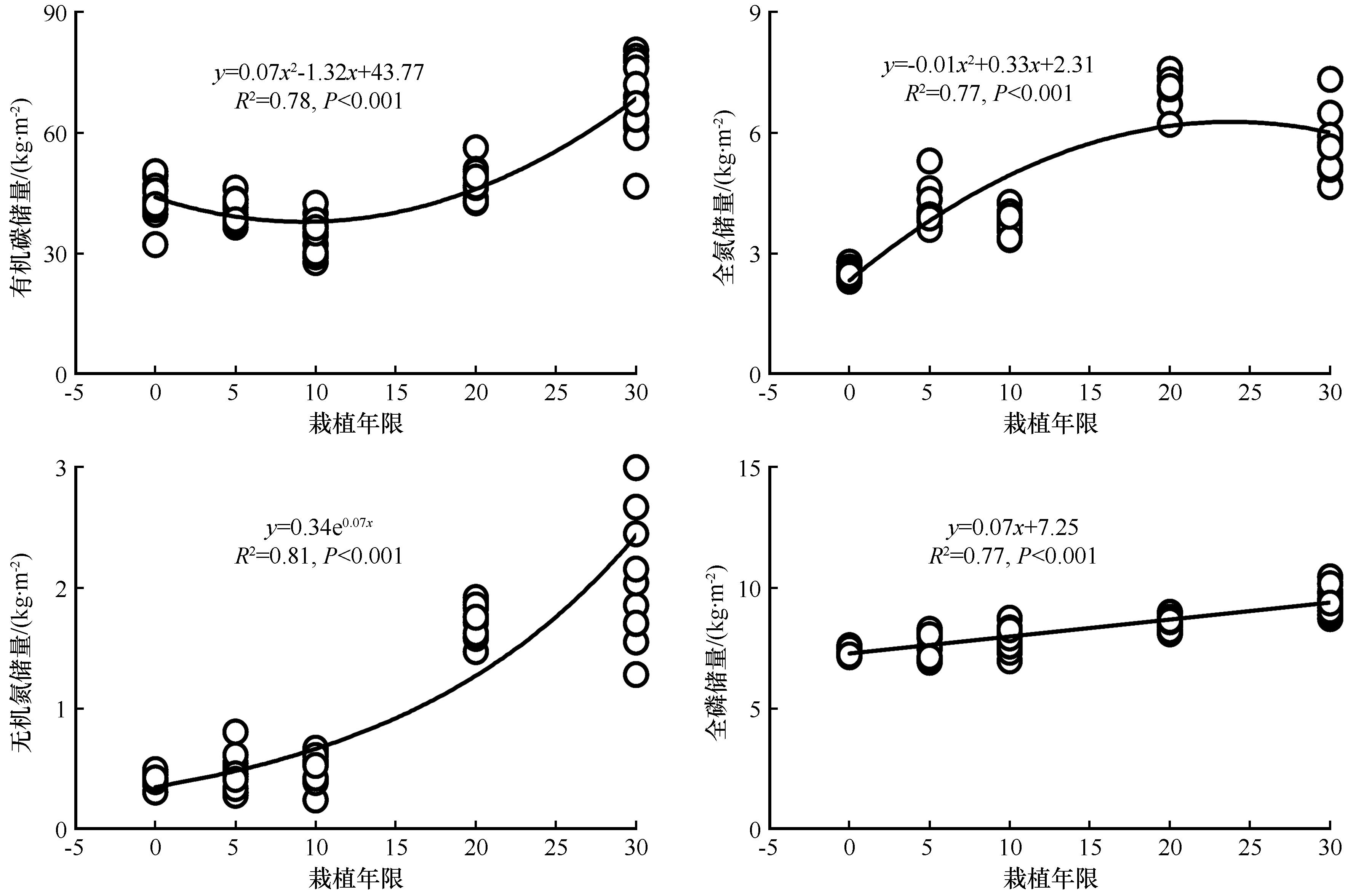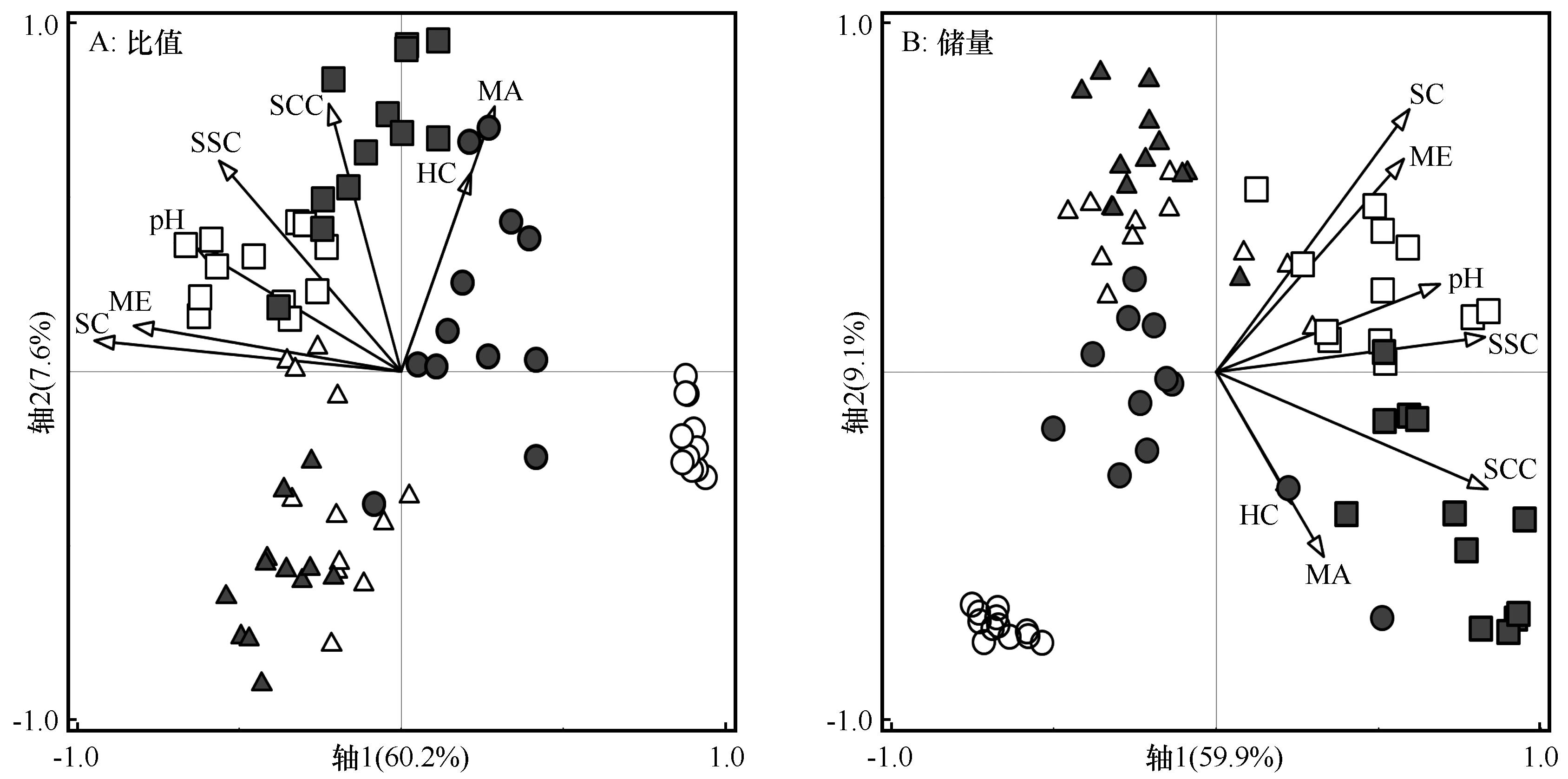
- CN 62-1070/P
- ISSN 1000-694X
- Bimonthly 1981

Journal of Desert Research ›› 2025, Vol. 45 ›› Issue (5): 241-252.DOI: 10.7522/j.issn.1000-694X.2025.00123
Ziting Wang1,2( ), Jiliang Liu3, Yongzhong Luo1(
), Jiliang Liu3, Yongzhong Luo1( ), Quanlin Ma1,2(
), Quanlin Ma1,2( ), Xiaogan Zhou1, Xin Luo1, Wenzhen Zong2
), Xiaogan Zhou1, Xin Luo1, Wenzhen Zong2
Received:2025-03-28
Revised:2025-05-31
Online:2025-09-20
Published:2025-09-27
Contact:
Yongzhong Luo, Quanlin Ma
CLC Number:
Ziting Wang, Jiliang Liu, Yongzhong Luo, Quanlin Ma, Xiaogan Zhou, Xin Luo, Wenzhen Zong. Long-term effects of Haloxylon ammodendron plantations on topsoil carbon, nitrogen, phosphorus stoichiometry and stocks in the desert-oasis ecotone[J]. Journal of Desert Research, 2025, 45(5): 241-252.
Add to citation manager EndNote|Ris|BibTeX
URL: http://www.desert.ac.cn/EN/10.7522/j.issn.1000-694X.2025.00123

Fig.1 The ratios of topsoil organic carbon, total nitrogen, and total phosphorus in mobile sandy dunes (MSD), fixed sandy dunes (FSD), and Haloxylon ammodendron plantations (Ys)

Fig.2 The storages of topsoil organic carbon, total nitrogen, inorganic nitrogen, and total phosphorus in mobile sandy dunes (MSD), fixed sandy dunes (FSD), and Haloxylon ammodendron plantations (Ys)

Fig.3 Changes in topsoil organic carbon, total nitrogen, inorganic nitrogen and total phosphorus stocks during the restoration of Haloxylon ammodendron plantations
| 变量 | 特征值(校准) | 解释量 | 贡献率 | F | P |
|---|---|---|---|---|---|
| 表层碳氮磷比值 | |||||
| SC | 0.541 | 54.05 | 79.61 | 91.2 | 0.001 |
| HC | 0.067 | 6.68 | 9.85 | 13.2 | 0.002 |
| MA | 0.035 | 3.53 | 5.2 | 7.7 | 0.002 |
| ME | 0.003 | 0.29 | 0.42 | 0.7 | 0.443 |
| SCC | 0.016 | 1.62 | 2.39 | 3.7 | 0.044 |
| pH | 0.011 | 1.15 | 1.69 | 2.6 | 0.089 |
| SSC | 0.006 | 0.57 | 0.84 | 1.4 | 0.235 |
| 表层碳氮磷储量 | |||||
| SC | 0.151 | 15.08 | 21.33 | 27.2 | 0.001 |
| HC | 0.014 | 1.44 | 2.04 | 3.7 | 0.029 |
| MA | 0.032 | 3.17 | 4.48 | 7.5 | 0.004 |
| ME | 0.002 | 0.19 | 0.27 | 0.4 | 0.682 |
| SCC | 0.427 | 42.75 | 60.46 | 56.1 | 0.001 |
| pH | 0.063 | 6.34 | 8.97 | 13.5 | 0.001 |
| SSC | 0.017 | 1.73 | 2.45 | 4.3 | 0.019 |
Table 1 pRDA to quantify the relative contributions of the relative influence of biotic and abiotic factors on alterations in the ratios and stocks of topsoil organic carbon, total nitrogen and total phosphorus
| 变量 | 特征值(校准) | 解释量 | 贡献率 | F | P |
|---|---|---|---|---|---|
| 表层碳氮磷比值 | |||||
| SC | 0.541 | 54.05 | 79.61 | 91.2 | 0.001 |
| HC | 0.067 | 6.68 | 9.85 | 13.2 | 0.002 |
| MA | 0.035 | 3.53 | 5.2 | 7.7 | 0.002 |
| ME | 0.003 | 0.29 | 0.42 | 0.7 | 0.443 |
| SCC | 0.016 | 1.62 | 2.39 | 3.7 | 0.044 |
| pH | 0.011 | 1.15 | 1.69 | 2.6 | 0.089 |
| SSC | 0.006 | 0.57 | 0.84 | 1.4 | 0.235 |
| 表层碳氮磷储量 | |||||
| SC | 0.151 | 15.08 | 21.33 | 27.2 | 0.001 |
| HC | 0.014 | 1.44 | 2.04 | 3.7 | 0.029 |
| MA | 0.032 | 3.17 | 4.48 | 7.5 | 0.004 |
| ME | 0.002 | 0.19 | 0.27 | 0.4 | 0.682 |
| SCC | 0.427 | 42.75 | 60.46 | 56.1 | 0.001 |
| pH | 0.063 | 6.34 | 8.97 | 13.5 | 0.001 |
| SSC | 0.017 | 1.73 | 2.45 | 4.3 | 0.019 |

Fig.4 The RDA two-dimensional ordination diagram of the ratios (A) and stocks (B) of topsoil organic carbon, total nitrogen and total phosphorus with biotic and abiotic factors among mobile sandy dune (MSD), fixed sandy dune (FSD) and Haloxylon ammodendron plantations (Ys)
| [1] | 朱震达,陈广廷.中国土地沙质荒漠化[M].北京:科学出版社,1994. |
| [2] | Su Y Z, Zhao W Z, Su P X,et al.Ecological effects of desertification control and desertified land reclamation in an oasis-desert ecotone in an arid region:a case study in Hexi Corridor,Northwest China[J].Ecological Engineering,2007,29:117-124. |
| [3] | Zhao W Z, Chang X L.The effect of hydrologic process changes on NDVI in the desert-oasis ecotone of the Hexi Corridor[J].Science China Earth Sciences,2014,57(12):3107-3117. |
| [4] | Zhao W Z, Hu G L, Zhang Z H,et al.Shielding effect of oasis-protection systems composed of various forms of wind break on sand fixation in an arid region: a case study in the Hexi Corridor,Northwest China[J].Ecological Engineering,2008,33:119-125. |
| [5] | 赵哈林,赵学勇,张铜会,等.我国西北干旱区的荒漠化过程及其空间分异规律[J].中国沙漠,2011,31(1):1-8. |
| [6] | Wang T, Xue X, Zhou L,et al.Combating aeolian desertification in Northern China[J].Land Degradation & Development,2012,26:118-132. |
| [7] | 李新荣,张志山,谭会娟,等.我国北方风沙危害区生态重建与恢复:腾格里沙漠土壤水分与植被承载力的探讨[J].中国科学:生命科学,2014,44(3):257-266. |
| [8] | Li X R, Zhao H L, Zhang J G.et al.Long‐term ecosystem effects of sand‐binding vegetation in the Tengger Desert,northern China[J].Restoration Ecology,2004,12:376-390. |
| [9] | Fan B L, Zhang A P, Yang Y,et al.Long-term effects of xerophytic shrub Haloxylon ammodendron plantations on soil properties and vegetation dynamics in Northwest China[J].PLoS One,2016,11(12):e0168000. |
| [10] | Zhang K, Su Y Z, Wang T,et al.Soil properties and herbaceous characteristics in an age sequence of Haloxylon ammodendron plantations in an oasis‐desert ecotone of Northwestern China[J].Journal of Arid Land,2016,8:960-972. |
| [11] | Yu K L, Wang G H.Long-term impacts of shrub plantations in a desert-oasis ecotone: accumulation of soil nutrients,salinity,and development of herbaceour layer[J].Land Degradation & Development,2018,29(8):2681-2693. |
| [12] | 李新荣,张志山,黄磊,等.我国沙区人工植被系统生态-水文过程和互馈机理研究评述[J].科学通报,2013,58():397-410. |
| [13] | Huang N, Li X Y, Liu H Y,et al.Effects of stand structure on ecological benefits and tree growth of Haloxylon ammodendron plantations: a meta-analysis[J].Land Degradation & Development,2024,35(15):4406-4418. |
| [14] | 李从娟,雷加强,徐新文,等.树干径流对梭梭“肥岛”和“盐岛”效应的作用机制[J].生态学报,2012,32(15):4819-4826. |
| [15] | Su Y Z, Liu T N, Kong J Q,et al.The establishment and development of Haloxylon ammodendron promotes salt accumulation in surface soil of arid sandy land[J].Sciences in Cold and Arid Regions,2019,11:0116-0125. |
| [16] | Orlovsky N, Birnbaum E.The role of Haloxylon species for combating desertification in central Asia[J].Plant Biosystems-An International Journal Dealing With All Aspects of Plant Biology,2002,136(2):233-240. |
| [17] | 郭泉水,王春玲,郭志华,等.我国现存梭梭荒漠植被地理分布及其斑块特征[J].林业科学,2005,41(5):2-7. |
| [18] | Li J Y, Chang H, Liu T,et al.The potential geographical distribution of Haloxylon across central Asia under climate change in the 21st century[J].Agricultural and Forest Meteorology,2019,275:243-254. |
| [19] | 张丹,马松梅,魏博,等.中国梭梭属植物历史分布格局及其驱动机制[J].生物多样性,2022,30(1):38-47. |
| [20] | 王佳琪,王国华,缑倩倩.荒漠绿洲过渡带人工梭梭(Haloxylon ammodendron)林下典型一年生草本植物空间格局[J].中国沙漠,2025,45(2):83-96. |
| [21] | 刘继亮,冯怡琳,王永珍,等.黑河中游人工固沙植被恢复对爬行类和兽类动物多样性的影响[J].中国沙漠,2024,44(6):167-177. |
| [22] | Zheng Y, Zhao W Z, Zhang G F.Spatial analysis of a Haloxylon ammodendron plantation in an oasis-desert ecotone in the Hexi Corridor,Northwestern China[J].Forests,2017,8(6):200. |
| [23] | 赵文智,郑颖,张格非.绿洲边缘人工固沙植被自组织过程[J].中国沙漠,2018,38(1):1-7. |
| [24] | 周晓甘,罗永忠,马全林,等.人工梭梭林建植对荒漠土壤特征的长期影响[J].中国沙漠,2025,45(5):68-77. |
| [25] | 王继和,张锦春,袁宏波,等.库姆塔格沙漠梭梭群落特征研究[J].中国沙漠,2007,27(5):809-813. |
| [26] | 司朗明,刘彤,信誉.古尔班通古特沙漠土壤因素对退化梭梭更新局限的影响[J].生态学杂志,2010,29(10):1925-1930. |
| [27] | 朱美菲,韩政伟,雷春英,等.准噶尔盆地荒漠绿洲过渡带地下水埋深对人工梭梭林年龄结构及动态特征的影响[J].生态学报,2024,44(19):8688-8698. |
| [28] | 卢建男,刘凯军,王瑞雄,等.中国荒漠植物-土壤系统生态化学计量学研究进展[J].中国沙漠,2022,42(2):173-182. |
| [29] | 王嘉瑞,周俊菊,朱国锋.中国土壤碳氮磷及生态化学计量研究综述[J].生态学杂志,2024,43(8):2493-2501. |
| [30] | 李从娟,徐新文,孙永强,等.不同生境下三种荒漠植物叶片及土壤C、N、P的化学计量特征[J].干旱区地理,2014,37(5):996-1004. |
| [31] | 张珂,苏永中,王婷,等.荒漠绿洲区不同种植年限人工梭梭林土壤化学计量特征[J].生态学报,2016,36(11):3235-3243. |
| [32] | 魏亚娟,汪季,党晓宏,等.干旱荒漠区人工梭梭林土壤碳氮磷密度与生态化学计量特征[J].水土保持学报,2022,36(3):259-266. |
| [33] | 张志山,杨贵森,吕星宇,等.荒漠生态系统C、N、P生态化学计量研究进展[J].中国沙漠,2022,42(1):48-56. |
| [34] | Liu J L, Li F R, Sun T S,et al.Interactive effects of vegetation and soil determine the composition and diversity of carabid and tenebrionid functional groups in an arid ecosystem[J].Journal of Arid Environments,2016,128:80-90. |
| [35] | Wang Z T, Liu J L, Luo Y Z,et al.Changes in tenebrionid beetle and ant assembly influenced by different-aged Haloxylon ammodendron plantations in Northwest China[J].Land Degradation & Development,2025,36(9):2940-2954. |
| [36] | 任嘉隆,王永珍,冯怡琳,等.基于陷阱法采集的河西走廊戈壁荒漠甲虫数据集[J].生物多样性,2024,32 (2):95-101. |
| [37] | 尹文英.中国土壤动物检索图鉴[M].北京:科学出版社,1998. |
| [38] | 郑乐怡,归鸿.昆虫分类[M].南京:南京师范大学出版社,1999. |
| [39] | 任国栋,于有志.中国荒漠半荒漠的拟步甲科昆虫[M].保定:河北大学出版社,1999. |
| [40] | Song D X, Zhu M S, Chen J.The Spiders of China[M].Baoding:Hebei Science and Technology Publishling House,1999. |
| [41] | Ter Braak C J F, Šmilauer P.Canoco Reference Manual and User's Guide: Software for Ordination[Z].Ithaca USA: Microcomputer Power,2012. |
| [42] | 李宁,周海,任珩,等.不同地下水位处梭梭(Haloxylon ammodendron)水分来源特征[J].中国沙漠,2021,41(4):79-86. |
| [43] | An H, Tang Z, Keesstra S,et al.Impact of desertification on soil and plant nutrient stoichiometry in a desert grassland[J].Scientific Reports,2019,9:9422 . |
| [44] | Liu J L, Zhao W Z, Li F R.Effects of shrub presence and shrub species on ground beetle assemblages (Carabidae,Curculionidae and Tenebrionidae) in a sandy desert,Northwestern China[J].Journal of Arid Land,2015,7:110-121. |
| [45] | Feng Y L, Wang Y Z, Ren J L,et al.Ground arthropod assemblages shaped by ant nests and shrub microhabitats in Gobi Desert ecosystems[J].Applied Soil Ecology,2025,212:106118. |
| [46] | Bui E N, Henderson B L.C∶N∶P stoichiometry in Australian soils with respect to vegetation and environmental factors[J].Plant Soil,2013,373:553-568. |
| [47] | 宁虎森,罗青红,吉小敏,等.新疆甘家湖梭梭林碳、氮、磷、钾生态化学计量特征[J].水土保持研究,2017,24(6):68-73. |
| [48] | 冯怡琳,王永珍,林永一,等.河西走廊中部荒漠收获蚁(Messor desertus)蚁穴对秋季地表节肢动物群落结构的影响[J].中国沙漠,2023,43(6):121-130. |
| [49] | 陶冶,刘耀斌,吴甘霖,等.准噶尔荒漠区域尺度浅层土壤化学计量特征及其空间分布格局[J].草业学报,2016,25(7):13-23. |
| [50] | An F J, Niu Z R, Liu T N,et al.Succession of soil bacterial community along a 46-year choronsequence artificial revegetation in an arid oasis-desert ecotone[J].Science of the Total Environment,2022,814:152496. |
| [51] | 苏永中,刘婷娜.流动沙地建植人工固沙梭梭林的土壤演变过程[J].土壤学报,2020,57(1):84-91. |
| [52] | 安芳娇,苏永中,牛子儒,等.干旱区流动沙地建植梭梭(Haloxylon ammodendron)林后细粒物质输入对土壤碳氮积累的影响[J].中国沙漠,2021,41(5):147-156. |
| [53] | 吉小敏,孙慧瑛,宁虎森,等.准噶尔盆地西缘天然梭梭林土壤有机碳及养分的分布特征[J].干旱区资源与环境,2014,28(12):148-153. |
| [54] | 马全林,尚雯,王新友,等.风沙活动对人工梭梭(Haloxylon ammodendron)林土壤碳氮含量的影响[J].中国沙漠,2022,42(1):71-78. |
| [55] | 贺郝钰,刘蔚,常宗强,等.腾格里沙漠南缘植被恢复对土壤有机碳组成及稳定性的影响[J].中国沙漠,2024,44(6):307-317. |
| [56] | Nielsen U N, Ball B A.Impacts of altered precipitation regimes on soil communities and biogeochemistry in arid and semi‐arid ecosystems[J].Global Change Biology,2015,21(4):1407-1421. |
| [57] | 安芳娇,苏永中,牛子儒,等.干旱区荒漠绿洲过渡带建植梭梭(Haloxylon ammodendron)林后土壤线虫群落演变[J].中国沙漠,2024,44(2):133-142. |
| [58] | Ma Q L, Wang X Y, Chen F,et al.Carbon sequestration of sand-fixing plantation of Haloxylon ammodendron in Shiyang River Basin: storage,rate and potential[J].Global Ecology and Conservation,2021,28:e01607. |
| [59] | Song J, Wan S Q, Zhang K S,et al.Ecological restoration enhances dryland carbon stock by reducing surface soil carbon loss due to wind erosion[J].Proceedings of the National Academy of Sciences of the United States of America,2024,121(46):e2416281121. |
| [60] | 刘继亮,李锋瑞,牛瑞雪,等.黑河中游不同土地利用方式地面节肢动物对土壤盐渍化的响应[J].土壤学报,2011,48(6):134-144. |
| [61] | Liu J L, Li F R, Liu L L,et al.Responses of different collembola and mite taxa to experimental rain pulses in an arid ecosystem[J].Catena,2017,155:53-61. |
| [62] | Mallen‐Cooper M, Nakagawa S, Eldridge D J.Global meta‐analysis of soil‐disturbing vertebrates reveals strong effects on ecosystem patterns and processes[J].Global Ecology and Biogeography,2019,28(5):661-679. |
| Viewed | ||||||
|
Full text |
|
|||||
|
Abstract |
|
|||||
©2018Journal of Desert Research
Tel:0931-8267545
Email:caiedit@lzb.ac.cn;desert@lzb.ac.cn
Support:Magtech